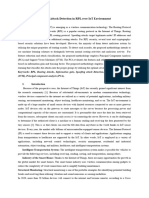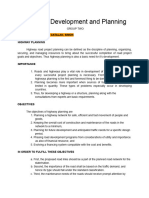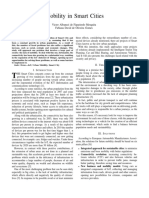AI For Networking
AI For Networking
Uploaded by
taosmonsta11Copyright:
Available Formats
AI For Networking
AI For Networking
Uploaded by
taosmonsta11Original Title
Copyright
Available Formats
Share this document
Did you find this document useful?
Is this content inappropriate?
Copyright:
Available Formats
AI For Networking
AI For Networking
Uploaded by
taosmonsta11Copyright:
Available Formats
AI for Networking: A Comprehensive Exploration by a Network Engineer
Artificial Intelligence (AI) is no longer just a futuristic concept; it has permeated multiple domains of
technology, and one of the most transformative areas is in networking. Networking is increasingly
becoming more complex due to the ever-growing number of devices, increased traffic loads, and
heightened security concerns. The application of AI in networking introduces automation, intelligence, and
optimization to networks, leading to more resilient, agile, and efficient infrastructures. As network traffic
surges and infrastructures scale, AI technologies are becoming critical to address challenges that
traditional networks simply cannot handle.
1. AI-Powered Traffic Analysis and Optimization
AI plays a vital role in managing traffic flow in modern networks. With the growing complexity of network
traffic, managing congestion, latency, and bandwidth distribution becomes increasingly difficult. AI
leverages machine learning (ML) algorithms to identify patterns in traffic data and predict future network
behavior. By analyzing real-time traffic patterns, AI systems can optimize routing decisions, dynamically
allocate bandwidth, and prevent potential congestion before it happens. This predictive capability can
significantly improve network efficiency, especially in high-demand environments such as data centers,
cloud computing, and large enterprise networks.
In practice, AI can monitor traffic trends over time, detect recurring patterns of congestion, and predict
when and where issues are likely to arise. Based on these insights, AI-driven systems can make
adjustments, such as rerouting traffic, adjusting Quality of Service (QoS) policies, or even allocating
additional resources to high-priority services. For instance, in a VoIP or video conferencing environment,
where low latency is crucial, AI can prioritize those traffic flows, ensuring a seamless experience for
users, even during peak periods.
Example: A network utilizing AI traffic management might predict that a specific link will become
congested due to a seasonal increase in traffic. The AI system can proactively adjust routing paths or
increase bandwidth allocation to mitigate the impact, thus maintaining optimal performance without
human intervention.
2. Autonomous Network Management and Automation
One of the most significant applications of AI in networking is automation. Traditional networking
management, with its reliance on manual configuration, monitoring, and troubleshooting, is often
cumbersome, time-consuming, and prone to human error. AI revolutionizes network management by
automating many of these tasks, reducing the workload on network administrators and minimizing
operational risks.
AI-powered network management systems can perform tasks like device configuration, fault detection,
performance monitoring, and software updates automatically. Machine learning algorithms continually
monitor network health, analyzing real-time data to detect potential issues such as degraded
performance, unresponsive devices, or misconfigurations. Once a problem is detected, the system can
diagnose the root cause and take corrective action, such as adjusting routing, isolating the fault, or even
reconfiguring the network to restore normal operations.
For instance, in a scenario where a network experiences an unexpected drop in throughput due to a
misconfigured router, AI systems can automatically identify the issue, adjust configurations, and
re-establish the connection without manual intervention. This not only reduces the downtime but also
eliminates the risk of human error in critical situations.
3. Network Security with AI
In the era of sophisticated cyberattacks, network security has become a critical concern. Traditional
security mechanisms, such as firewalls and intrusion detection systems (IDS), are reactive, only
identifying and responding to threats after they have penetrated the network. However, the scale and
complexity of modern cyberattacks require a more proactive and intelligent defense strategy. This is
where AI steps in.
AI enhances network security by using machine learning to detect anomalies and patterns in network
traffic that may indicate a security breach. By continuously analyzing network behavior, AI can identify
malicious activities such as Distributed Denial of Service (DDoS) attacks, phishing attempts, or
unauthorized access much faster than traditional security tools. AI’s real-time detection and analysis
capabilities enable it to respond immediately to potential threats, often isolating or mitigating the attack
before any real damage is done.
Anomaly detection algorithms can learn the normal behavior of network traffic over time, and once they
detect a deviation from this pattern, they trigger alarms or take automatic action to mitigate the threat. For
instance, if a device starts generating unusually high volumes of traffic (a sign of a potential botnet or
DDoS attack), the AI system can isolate the device or reroute traffic to minimize the impact.
Example: AI-based intrusion detection systems can spot zero-day vulnerabilities by recognizing unusual
behavior patterns that are typical of new or unknown attack vectors, providing faster mitigation compared
to signature-based methods.
4. Predictive Maintenance and Network Self-Healing
AI’s ability to predict failures and enable proactive maintenance is another key benefit in networking.
Predictive maintenance uses machine learning models that analyze historical data, such as hardware
performance metrics, to predict when network devices like routers, switches, or firewalls might fail. By
identifying potential issues before they become critical, AI can schedule maintenance or replacement,
reducing the risk of unexpected downtime.
Beyond predictive maintenance, AI is also driving the concept of self-healing networks. In self-healing
networks, AI-driven systems can automatically detect issues, diagnose the root causes, and take
corrective actions to restore normal operations without human intervention. This includes rerouting traffic,
adjusting configurations, and even reinitializing devices that may have failed.
For example, if a network switch begins to malfunction due to a hardware issue, AI systems could detect
a performance drop, automatically reroute traffic to other operational switches, and notify administrators
for further inspection. This reduces network downtime and ensures uninterrupted service.
5. AI for Network Design and Optimization
AI is also being used to optimize network design, especially in large-scale or highly dynamic
environments. Traditionally, network design involved static configurations, requiring manual adjustments
whenever changes were needed. However, AI can take into account dynamic factors such as traffic
patterns, device performance, and future expansion needs to suggest optimal network architectures.
AI-driven network design tools can simulate different scenarios and recommend the most efficient
configurations, such as optimal placement of routers and switches, determining the best load balancing
methods, and ensuring fault tolerance. This leads to more resilient networks, able to handle increased
traffic and unpredictable demands with minimal human intervention.
For example, when setting up a new data center, AI algorithms can recommend the best network
topology, taking into account factors like available bandwidth, redundancy, power consumption, and cost.
AI can even suggest ways to balance workloads efficiently across the network, ensuring high availability
and performance.
6. Integration with 5G and IoT Networks
AI is an integral part of the emerging 5G and Internet of Things (IoT) networks. 5G networks require
unprecedented levels of performance and low latency, which makes AI essential for managing resources
dynamically. AI can help optimize 5G network slices, ensuring each slice performs optimally for specific
applications such as autonomous vehicles or healthcare monitoring.
Similarly, AI in IoT networks can manage the large volumes of data generated by connected devices. AI
systems can monitor device health, predict connectivity issues, and ensure that the network can scale to
accommodate the increasing number of IoT devices. AI-enabled edge computing can also be deployed in
IoT systems to process data closer to the source, reducing latency and improving the responsiveness of
IoT devices.
Example: In a smart city, AI can manage the vast amounts of data generated by connected sensors,
adjusting traffic signals in real time based on current traffic conditions, reducing congestion, and
improving overall efficiency.
7. AI in SD-WAN (Software-Defined Wide Area Networks)
AI is also transforming the way we approach WANs. Software-Defined WAN (SD-WAN) is an emerging
technology that allows organizations to simplify and optimize their wide-area network infrastructure. By
incorporating AI into SD-WAN, organizations can improve traffic management by making intelligent
decisions on path selection and optimizing traffic flows across various links (e.g., MPLS, broadband,
LTE).
AI can continuously monitor network performance and adjust routing in real-time, ensuring the most
efficient path is used for each application based on its priority and performance requirements. This makes
SD-WANs more agile, cost-effective, and resilient to failures.
Conclusion
AI is no longer a theoretical concept in the networking domain—it is already driving innovation, efficiency,
and security in modern networks. From traffic optimization and network automation to enhanced security
and self-healing networks, AI is poised to transform the way we design, manage, and secure networks.
The integration of AI with emerging technologies such as 5G and IoT will further enhance the capabilities
of networks, making them smarter, more adaptable, and more resilient.
As the world continues to rely more heavily on networked systems for critical services, AI will become a
cornerstone of network management, allowing organizations to scale, optimize, and secure their networks
more effectively than ever before. The future of networking is indeed intelligent, automated, and
AI-driven.
You might also like
- BS en 01253-1-2015 PDFDocument36 pagesBS en 01253-1-2015 PDFsam100% (1)
- Highway Development and Planning PDFDocument59 pagesHighway Development and Planning PDFjun junNo ratings yet
- Telegram BotsDocument14 pagesTelegram Botsصلاح خيريNo ratings yet
- The_Role_of_AI_in_Simplifying_Network_ManagementDocument2 pagesThe_Role_of_AI_in_Simplifying_Network_Managementmstarktrack199No ratings yet
- Network Automation and AIDocument13 pagesNetwork Automation and AIAhmed Sheraz LaghariNo ratings yet
- Revolutionizing Network Engineering Utilizing Artificial Intelligence For Network Management and OpDocument8 pagesRevolutionizing Network Engineering Utilizing Artificial Intelligence For Network Management and OpcmrwarmyNo ratings yet
- AI-Powered Network Automation 5Document10 pagesAI-Powered Network Automation 5khalid.hasan.bjitNo ratings yet
- Mastering Network Automation 10Document10 pagesMastering Network Automation 10hjranwmNo ratings yet
- Top AI Use Cases For TelcosDocument30 pagesTop AI Use Cases For Telcos5g.training.videosNo ratings yet
- AI and ML As The Foundations of 5G Network Monitoring (White Paper)Document6 pagesAI and ML As The Foundations of 5G Network Monitoring (White Paper)Samir HamdiNo ratings yet
- Programmable Networks Service Ai ML Operation NewDocument6 pagesProgrammable Networks Service Ai ML Operation NewShaurya KapoorNo ratings yet
- IOT and New Era of Edge processingDocument7 pagesIOT and New Era of Edge processingSamiha AshrafiNo ratings yet
- A Guide To Enterprise Network ManagementDocument15 pagesA Guide To Enterprise Network ManagementNathaniel EtukNo ratings yet
- iot-comm-unit-1-notesDocument23 pagesiot-comm-unit-1-notesthakur.aditya562004No ratings yet
- AI in Communication NetworksDocument14 pagesAI in Communication Networksvychuvyshnav491No ratings yet
- Exploring the potential of AI-driven optimization in enhancing network performance and efficiencyDocument11 pagesExploring the potential of AI-driven optimization in enhancing network performance and efficiencyAksks BksksNo ratings yet
- Network Performance Monitoring and DiagnosticsDocument10 pagesNetwork Performance Monitoring and DiagnosticsTech CityNo ratings yet
- HUAWEI Esight DatasheetDocument18 pagesHUAWEI Esight Datasheetali hamidNo ratings yet
- Ai in Communication ElectronicsDocument16 pagesAi in Communication ElectronicsAnuragNo ratings yet
- Edgecomputing AssignmentDocument10 pagesEdgecomputing AssignmentAnupama Wilson MCA22No ratings yet
- Dissertation On Wireless Sensor NetworkDocument4 pagesDissertation On Wireless Sensor NetworkDoMyPaperForMoneyDesMoines100% (1)
- Network Devices_ Importance, Functions and Types-1Document2 pagesNetwork Devices_ Importance, Functions and Types-1Abu SayeedNo ratings yet
- Huawei Imaster NCE-CampusInsight Data SheetDocument19 pagesHuawei Imaster NCE-CampusInsight Data SheetRichard RomeroNo ratings yet
- Artificial Intelligence and 5G TechnologyDocument4 pagesArtificial Intelligence and 5G Technologyabhishekvelpula11No ratings yet
- Connected Cars ThesisDocument5 pagesConnected Cars Thesisdawnrobertsonarlington100% (2)
- 6 - Edge ComputingDocument2 pages6 - Edge ComputingKARTHIKAYAN BNo ratings yet
- Challenges in Edge Computing: Artificial IntelligenceDocument4 pagesChallenges in Edge Computing: Artificial IntelligenceMarimuthu ANo ratings yet
- Trends in ComputingDocument8 pagesTrends in ComputingmammusidhiqNo ratings yet
- A Review Paper - Copy5Document23 pagesA Review Paper - Copy5Muhammad RafiqueNo ratings yet
- A Review Paper - Copy4Document19 pagesA Review Paper - Copy4Muhammad RafiqueNo ratings yet
- 60b69a03609f7bbbbb86ea8b - IoT Architecture White Paper - HologramDocument10 pages60b69a03609f7bbbbb86ea8b - IoT Architecture White Paper - HologramMike HollandNo ratings yet
- 5G Network Analysis With Machine LearningDocument6 pages5G Network Analysis With Machine LearningRoger ParsonsNo ratings yet
- AI in Wireless CommunicatioDocument15 pagesAI in Wireless CommunicatioAsimNo ratings yet
- It Culture and SocietyDocument7 pagesIt Culture and SocietyJhonavil ReyesNo ratings yet
- Network-Monitor-PDF-9th-BatchDocument4 pagesNetwork-Monitor-PDF-9th-Batchdasdaa4321No ratings yet
- Spoofing Attack Detection in RPL Over IoT Environmen1Document8 pagesSpoofing Attack Detection in RPL Over IoT Environmen1pranaysohamprabhaNo ratings yet
- Arista CUE WPDocument10 pagesArista CUE WPnisrineNo ratings yet
- Introduction To Autonomous Iot SystemsDocument10 pagesIntroduction To Autonomous Iot Systemssatradi610No ratings yet
- Iot LandDocument12 pagesIot LandbommireddyrishitaNo ratings yet
- 5G Edge Automation Optimization InDesign 1Document40 pages5G Edge Automation Optimization InDesign 1Ricardo ToyerosNo ratings yet
- Unit 1 - Internet of ThingsDocument11 pagesUnit 1 - Internet of ThingsAyesha MandloiNo ratings yet
- Seminario EdgeDocument29 pagesSeminario EdgeyovocNo ratings yet
- Acknowledgement Based Intrusion Detectionsystem in Mobile Ad-Hoc Networks Using EaackDocument12 pagesAcknowledgement Based Intrusion Detectionsystem in Mobile Ad-Hoc Networks Using EaackShrinidhi GowdaNo ratings yet
- The Rise of Edge Computing and Its Impact On Modern IT InfrastructureDocument2 pagesThe Rise of Edge Computing and Its Impact On Modern IT Infrastructureiconline701No ratings yet
- Report On The Internet of Things by MUNEEB-1Document16 pagesReport On The Internet of Things by MUNEEB-1taha riazNo ratings yet
- Smart Grid FarziDocument5 pagesSmart Grid FarziSiddhartha PorwalNo ratings yet
- Thesis Network TrafficDocument4 pagesThesis Network Trafficdwbeqxpb100% (2)
- RootCause End To End DeliveryDocument7 pagesRootCause End To End DeliveryprakashNMNo ratings yet
- Abstracted Network For IotDocument32 pagesAbstracted Network For Iotangelperez25No ratings yet
- UNIT 4 - Implementation of IoT With Raspberry PiDocument23 pagesUNIT 4 - Implementation of IoT With Raspberry Pirohitchoudhary2575No ratings yet
- A Review Paper - Copy3Document20 pagesA Review Paper - Copy3Muhammad RafiqueNo ratings yet
- Edge Computing: Presented By: John Barry Atim Abegail A. MiñozaDocument38 pagesEdge Computing: Presented By: John Barry Atim Abegail A. MiñozaIan SubingsubingNo ratings yet
- Unit IiiDocument23 pagesUnit Iiibhuvanachandra54No ratings yet
- LATTE LSTM Self-Attention Based Anomaly DetectionDocument24 pagesLATTE LSTM Self-Attention Based Anomaly Detection45pfzfsx7bNo ratings yet
- Spoofing Attack Detection in RPL Over IoT Environmen1Document7 pagesSpoofing Attack Detection in RPL Over IoT Environmen1pranaysohamprabhaNo ratings yet
- Thesis On Mobile Ad Hoc NetworkDocument4 pagesThesis On Mobile Ad Hoc Networkafkojxato100% (2)
- Artificial Intelligence Helps Solve Networking ProblemsDocument5 pagesArtificial Intelligence Helps Solve Networking ProblemsRiyaNo ratings yet
- Term Paper Project Designing A Secure NetworkDocument7 pagesTerm Paper Project Designing A Secure Networkeryhlxwgf100% (1)
- GayathriDocument43 pagesGayathriuhanjalikambampatiNo ratings yet
- Machine Learning PpptDocument9 pagesMachine Learning Pppt036ITE Md KaisharNo ratings yet
- Diction 2Document4 pagesDiction 2Elly StroberellyNo ratings yet
- Highway Engineering 2Document20 pagesHighway Engineering 2Cupid Phung100% (1)
- Highway Development and PlanningDocument10 pagesHighway Development and PlanningRufa May Auingan YbiasNo ratings yet
- Research Work Ap2Document34 pagesResearch Work Ap2Khian PinedaNo ratings yet
- GCOE, Jalgaon: Chapter 9. Stations and YardsDocument14 pagesGCOE, Jalgaon: Chapter 9. Stations and YardsudayNo ratings yet
- Transportation Risk ManajemenDocument84 pagesTransportation Risk ManajemenWenny SY KalaloNo ratings yet
- Latest S5294aDocument9 pagesLatest S5294aGersh KuntzmanNo ratings yet
- GV Đáp Án Unit 2 Lớp 9 GLOBAL SUCCESSDocument19 pagesGV Đáp Án Unit 2 Lớp 9 GLOBAL SUCCESSNguyễn Ngọc HươngNo ratings yet
- Frequently Asked Questions For Sb2938 Involving Transportation Funding User Fee AdjustmentsDocument5 pagesFrequently Asked Questions For Sb2938 Involving Transportation Funding User Fee AdjustmentsHonolulu Star-AdvertiserNo ratings yet
- Discussion QuestionDocument23 pagesDiscussion QuestionMALOLOY-ON, JEROME B.No ratings yet
- Dynamic Traffic Light Control System Based On Process Synchronization Among Connected VehiclesDocument11 pagesDynamic Traffic Light Control System Based On Process Synchronization Among Connected VehiclesJulina Jerez AbadiesNo ratings yet
- Synchro Studio 9 BrochureDocument4 pagesSynchro Studio 9 BrochureRaviteja TalluriNo ratings yet
- Parking Access Design Standards Handbook 2010Document25 pagesParking Access Design Standards Handbook 2010Sopheak ThapNo ratings yet
- 2021 Ford Edge Owners Manual Version 1 - Om - EN US - 12 - 2020Document500 pages2021 Ford Edge Owners Manual Version 1 - Om - EN US - 12 - 2020day alcoberNo ratings yet
- 2-Error CorrectionDocument6 pages2-Error CorrectionWilliam TsengNo ratings yet
- Masterseal Traffic 1330 TdsDocument3 pagesMasterseal Traffic 1330 TdsSolomon AhimbisibweNo ratings yet
- Fill in The Blanks With Clues JSC YS 1-30Document5 pagesFill in The Blanks With Clues JSC YS 1-30Kriti howlader100% (2)
- Intelligent Transportation SystemDocument27 pagesIntelligent Transportation SystemAngelica Suico MayolNo ratings yet
- 1334670994binder2Document39 pages1334670994binder2CoolerAdsNo ratings yet
- Venky Harinarayan and Sudha Neelakantan 09-13-17Document5 pagesVenky Harinarayan and Sudha Neelakantan 09-13-17L. A. PatersonNo ratings yet
- Mobility in Smart Cities: Victor Albanezi de Figueiredo Mesquita Fabiana David de Oliveira GomesDocument4 pagesMobility in Smart Cities: Victor Albanezi de Figueiredo Mesquita Fabiana David de Oliveira GomesVictor AlbaneziNo ratings yet
- قاموس الطرقDocument1 pageقاموس الطرقfdlNo ratings yet
- The Effect of Road Infrastructure On Traffic Accidents: Ardilson Pembuain, Sigit Priyanto, and Latif B. SuparmaDocument7 pagesThe Effect of Road Infrastructure On Traffic Accidents: Ardilson Pembuain, Sigit Priyanto, and Latif B. SuparmaPhạm VânNo ratings yet
- Collision Risk Analyses For Offshore Wind Energy InstallationsDocument7 pagesCollision Risk Analyses For Offshore Wind Energy InstallationsEirik ByklumNo ratings yet
- Effects of New Bus and Rail Rapid Transit Systems An International ReviewDocument22 pagesEffects of New Bus and Rail Rapid Transit Systems An International ReviewAkhilaNo ratings yet
- City of Tucson/Pima County Outdoor Lighting CodeDocument17 pagesCity of Tucson/Pima County Outdoor Lighting CodeKOLD News 13No ratings yet
- Assessment Road Safety Carmen Section, Agusan Del Norte.Document7 pagesAssessment Road Safety Carmen Section, Agusan Del Norte.halobibonhahaNo ratings yet
- Intel Construction EHS: Processes and Procedures ManualDocument127 pagesIntel Construction EHS: Processes and Procedures ManualRanjan BhaumikNo ratings yet

























































































